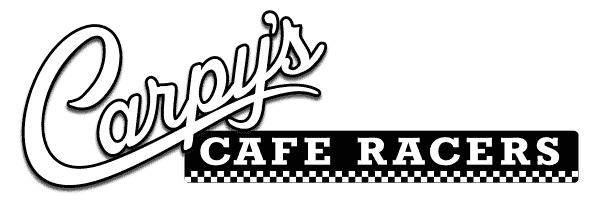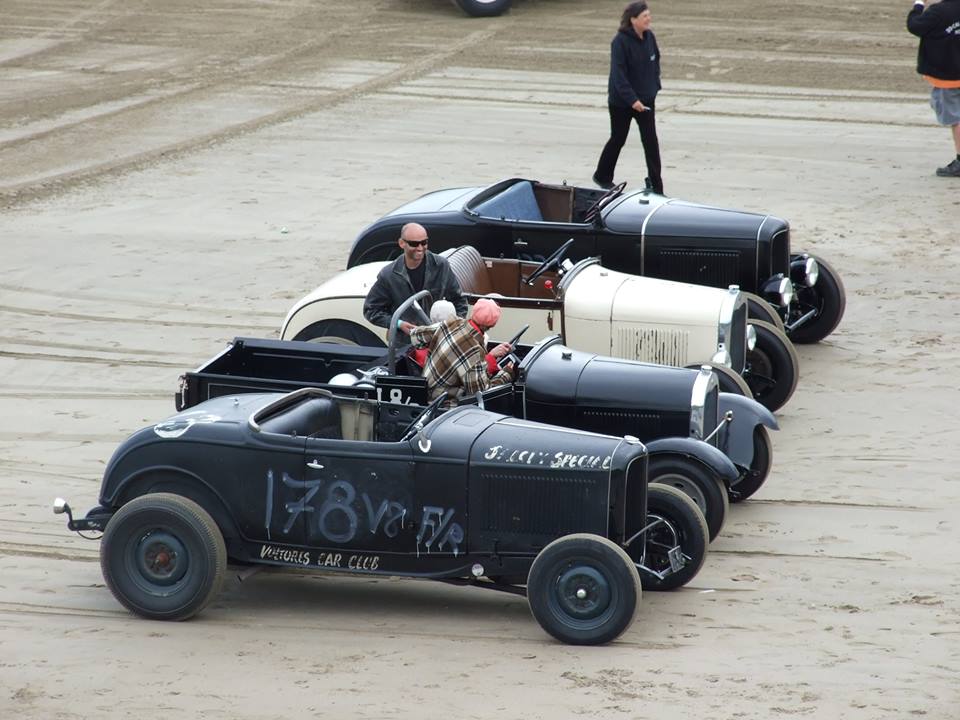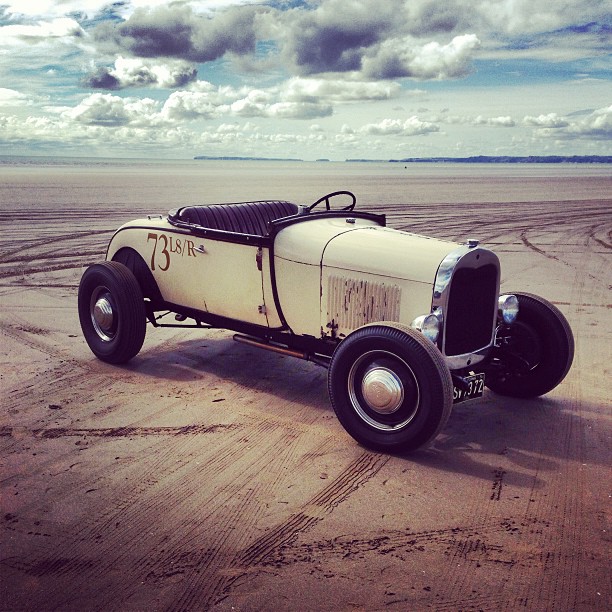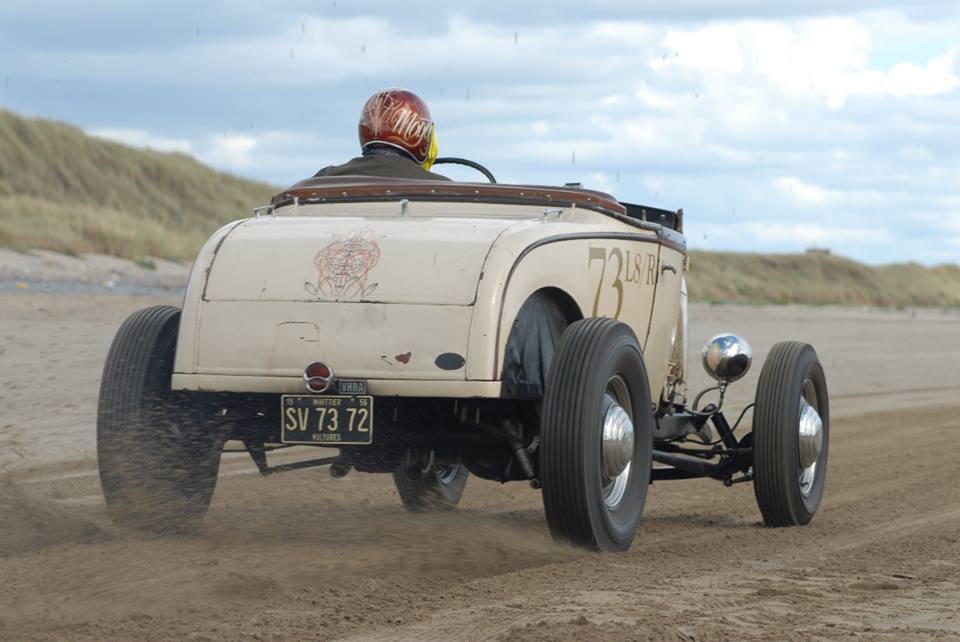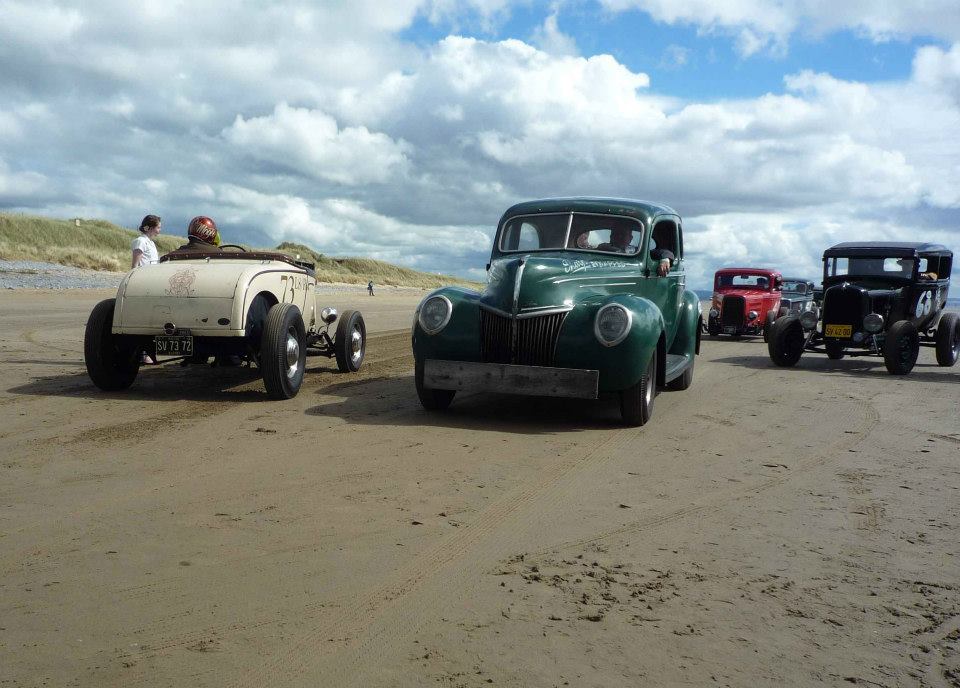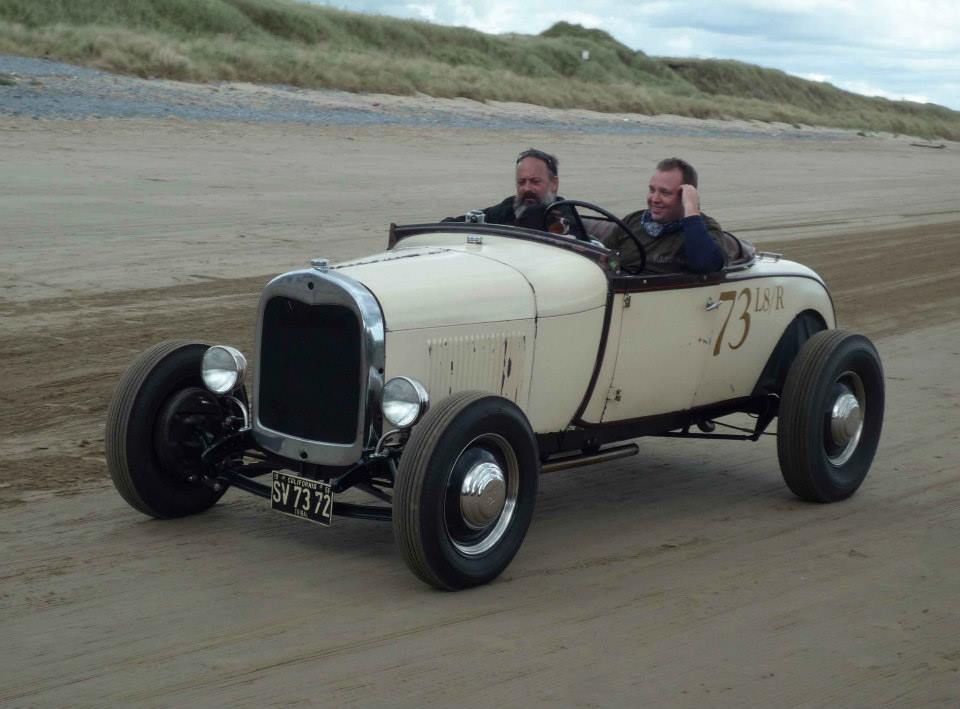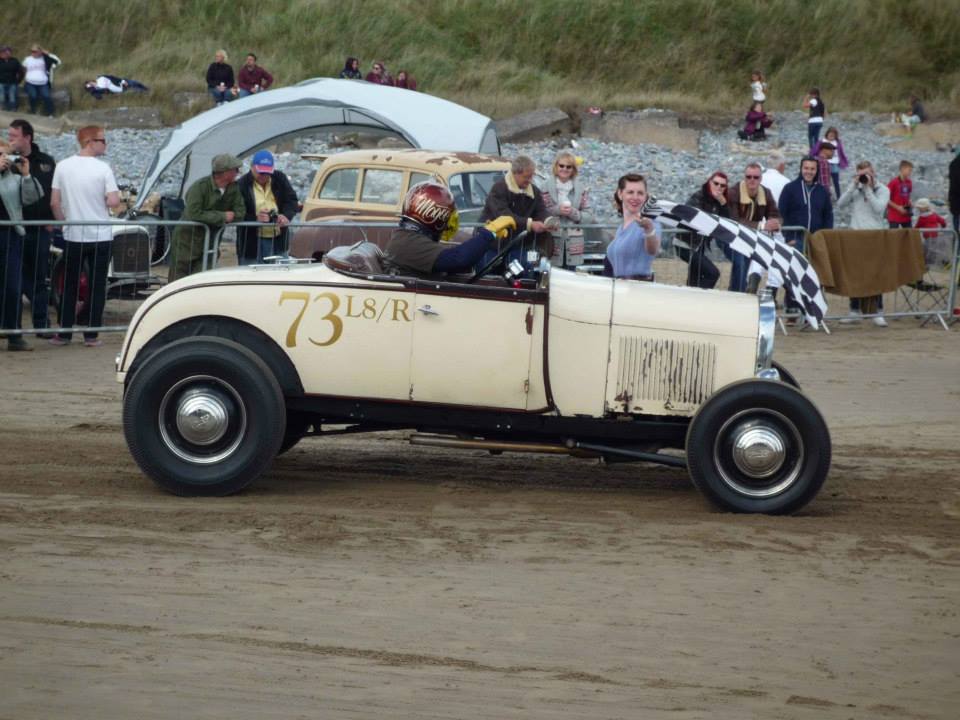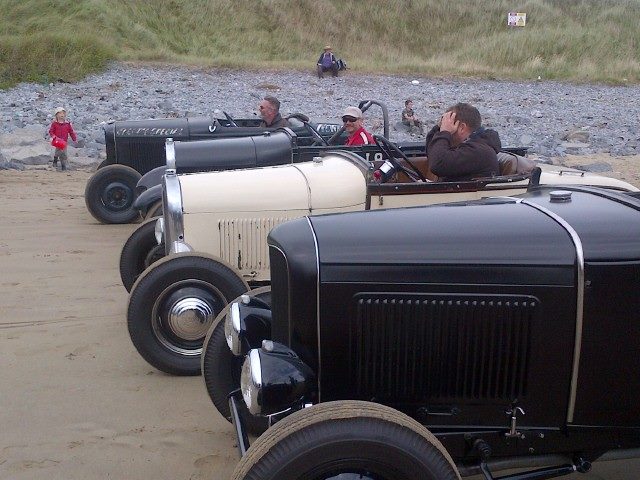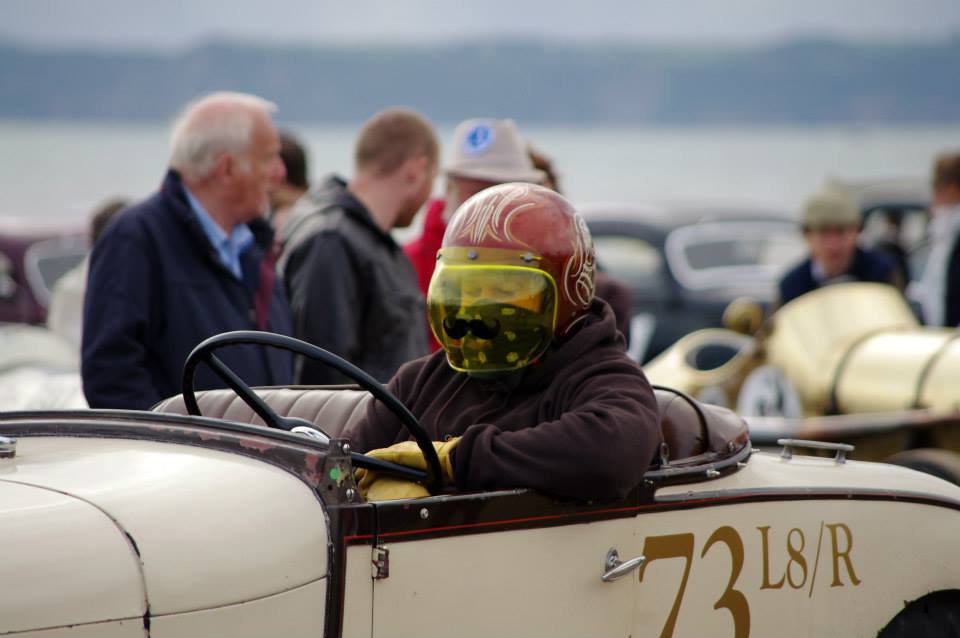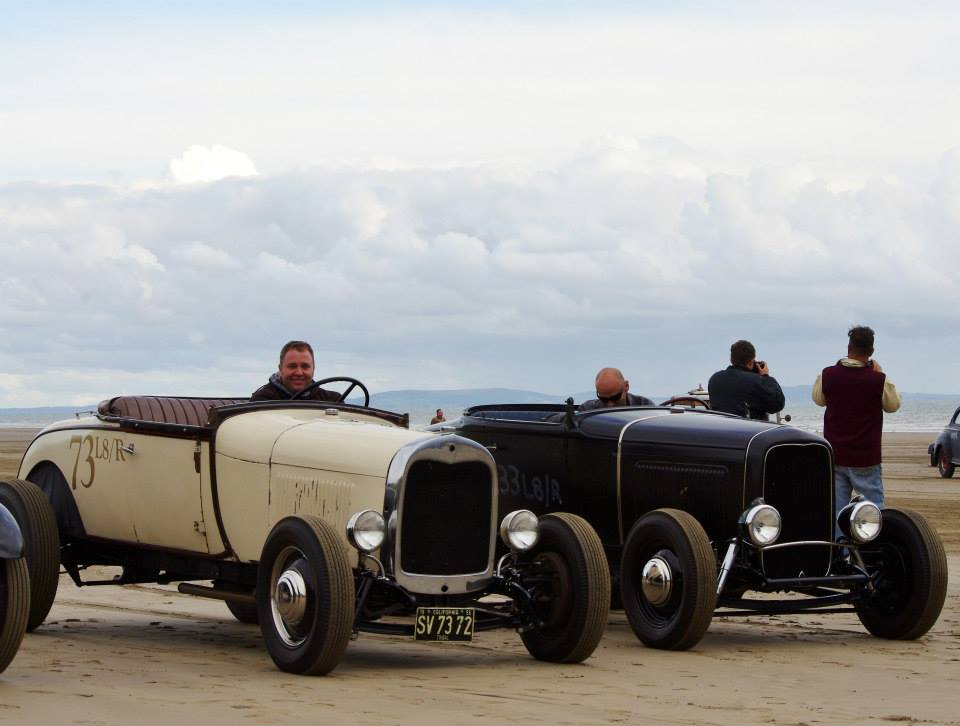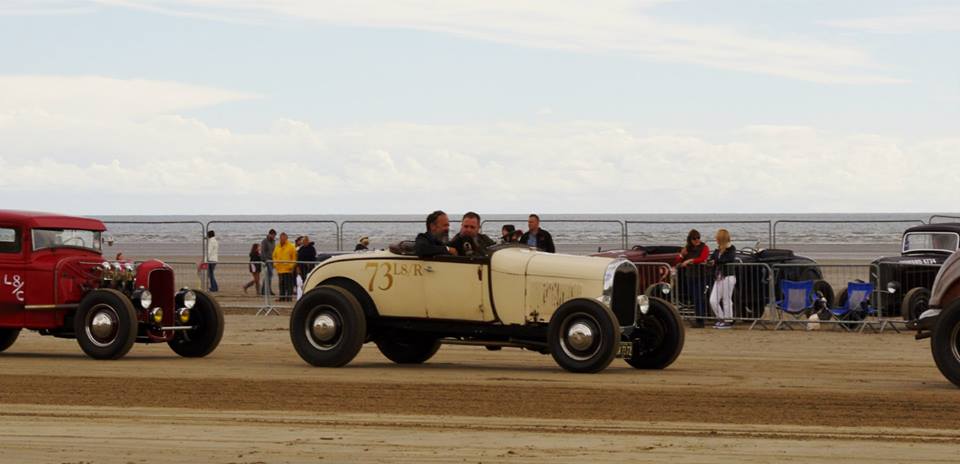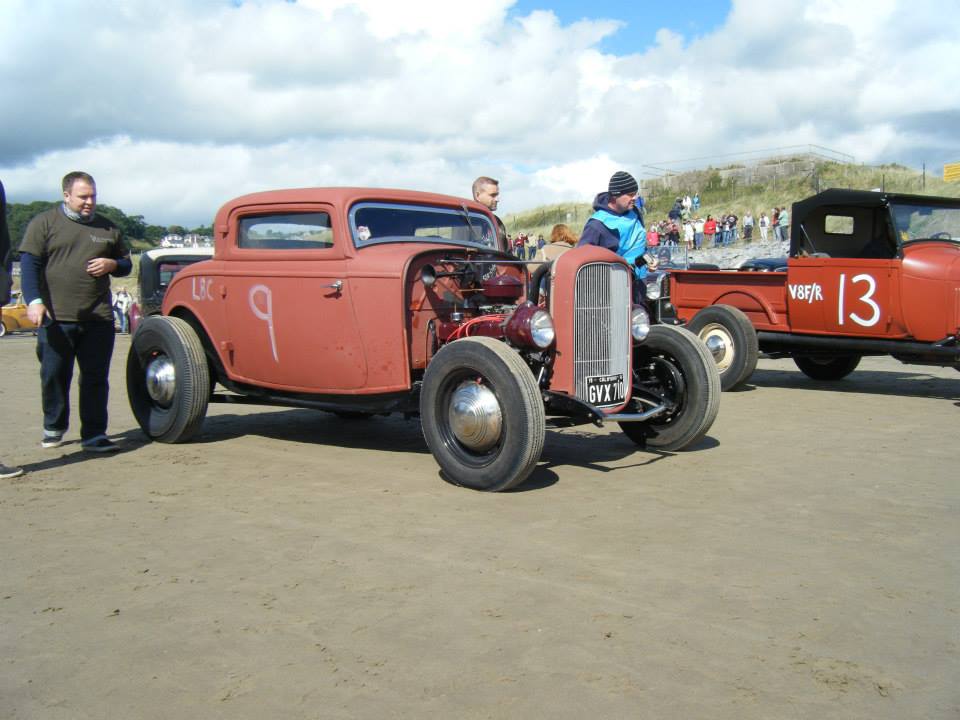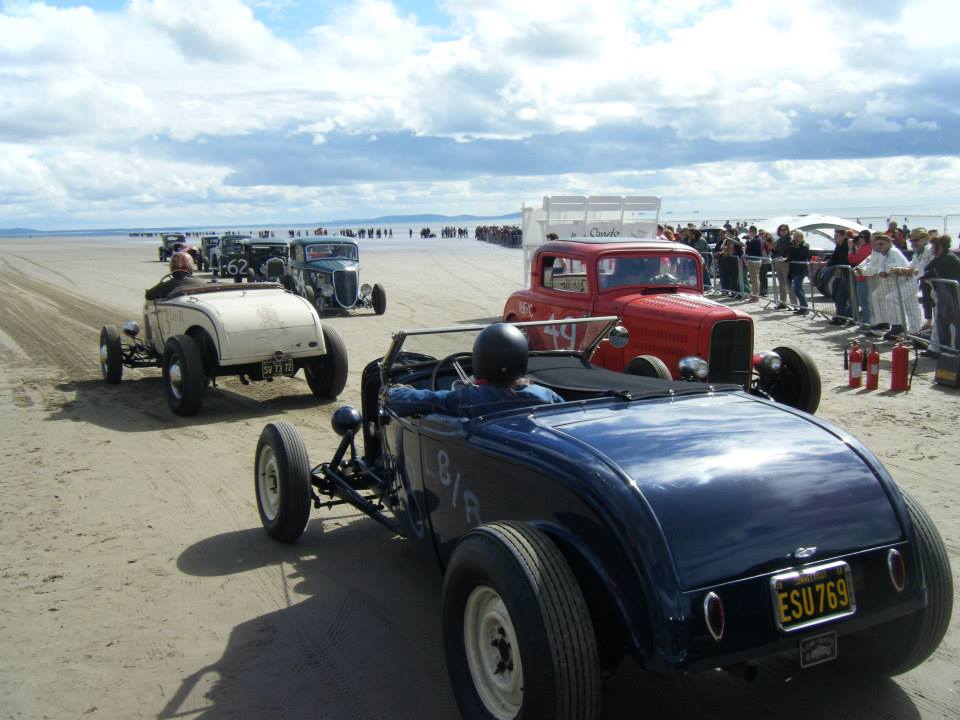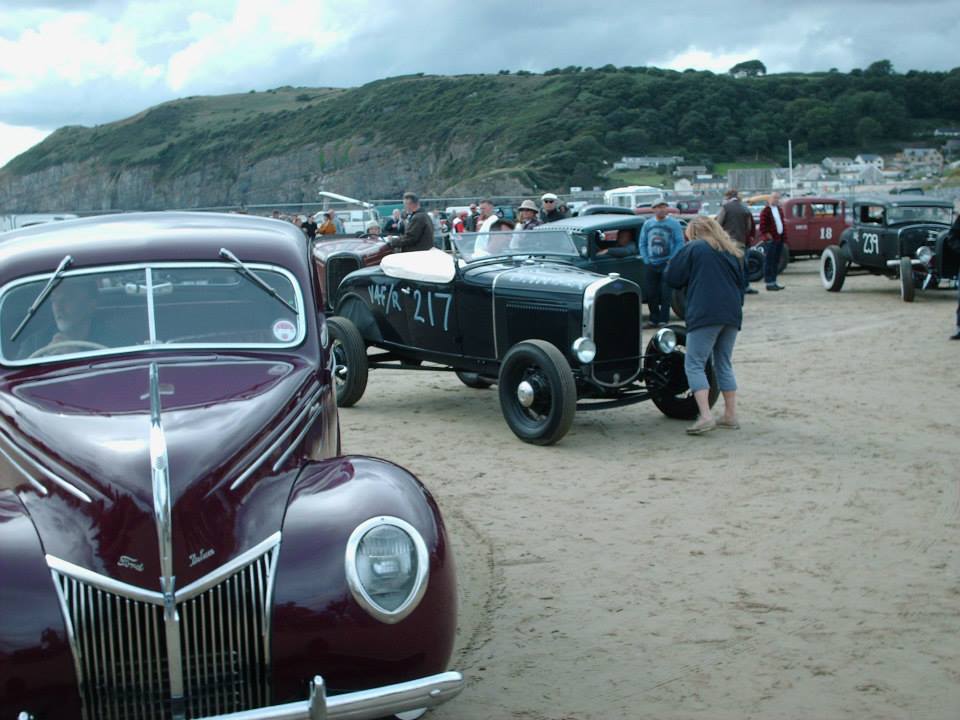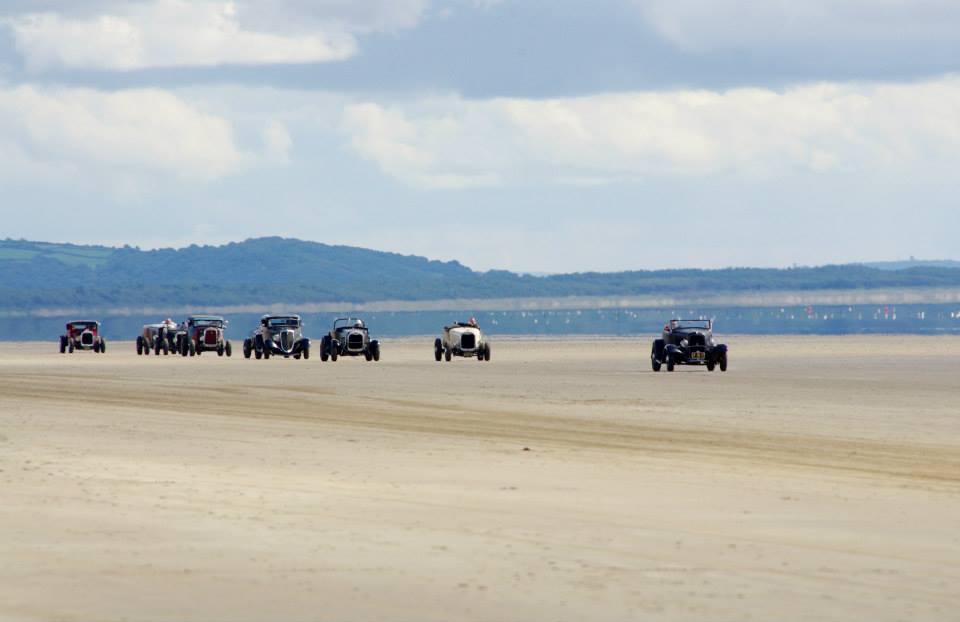No products in the cart.
PENDINE SANDS IN SOUTH WALES HAS AWESOME HOT ROD TURN OUT.
14
Sep
WHAT A GREAT EXHIBITION OF SUPER COOL HOT RODS AND VINTAGE TIN !
Here is all the news of the up and coming day and I have also added vids and other people write ups for you all to have a look at.

The Vintage Hot Rod Association presents:
Pendine Sands – Amateur Hot Rod Races
Racing is planned to commence at 11am on the 7th September

This is the big one! For years it has been discussed about taking hot rods to Pendine Sands, but until now it has not been a reality. We are so very proud to announce that the Vintage Hot Rod Association will be hosting the First Annual Hot Rod Races at Pendine Sands on Saturday, 7th September 2013.
Pendine Sands is a seven mile long, arrow straight beach in South West Wales and was the go to place in the 1920’s for land speed record attempts. Back then it drew big names such as Malcolm Campbell driving Bluebird, along with Parry Thomas piloting Babs, both hitting speeds in excess 170 miles per hour. It was following a terrible accident in 1927 when Thomas was decapitated that racing at Pendine Sands was called to a halt. For a little history lesson we recommend you take a look at the film below, the BBC tell it so much better then we do!
This is a chance for us here in the UK to at last have a go at what the US has taken for granted for many years, although ironically, those heroes of a bygone time were doing it here on Pendine Sands way before the hot rodders found their way to Muroc, El Mirage and Bonneville.








Racing Classes
V – Vintage – Pre 54 engines, inclusive of all Ford flathead V8’s
L – Late – Post 54 engines
4 – 4 Cylinder
6 – 6 Cylinder
8 – 8 Cylinder
U – Unlimited Cylinders
B – Blown – Supercharger or Turbo
F – Flathead – ALL valves in block, no OHV conversions
R – Roadster – Open top factory cars. Roof chops allowed, top must be down.
C – Closed Car – Fixed roof factory cars. Roof chops allowed.
M – Modified – Special & shortened bodies including any non factory bodies.
K – Full Body – Factory cars post 1934. All body styles, roof chops allowed. Full fenders must be fitted.
To give a few examples, if you run a 1932 roadster with a blown flathead, you’ll be running in V8BF/R. A 4 banger with an OHV conversion in a T speedster would be in V4/M, and a 1940 Ford custom running a Thunderbird engine would be L8/K. So as you can see, there are plenty of permutations and lots of opportunities to set class records.
Entry Conditions
Cars will be timed over a flying quarter mile and racing is open to all members of the VHRA and their VHRA eligible cars. To compete on the sand the cost is £30. Pit crew can sign on and have full access for a further £10 a head. If you have a car that won’t be competing, then to gain access to the pit area it’s £10 for each person in the car. Pit entry on foot is £10 per person. All these options will gain you access to the after race party. Please note that there is a cut off of pre-49 for racing, and up to 1954 for cars in the pit area and they do have to be “in period”. There is a maximum of around 100 competing cars and also a limit on pit passes available, with places going to VHRA members first. So, if you don’t want to miss out on this unique opportunity, print off the application form and get it back to us post haste. – PLEASE NOTE THAT AS OF 8th AUGUST ALL RACE & PIT PASSES HAVE BEEN SOLD. NO FURTHER BOOKINGS ARE BEING TAKEN.
If you just wish to come and spectate, then there is a fee of £3 payable on the day, which does allow you access to the beach in your car in the public car park, but it will not permit you to enter the pit or race areas, nor will you be have access to the after race party on Saturday night. No pre-booking is required.
Accommodation
For those wishing to stay nearby there are a number of options. If you are quick then the Parkdean Caravan Park across the road is the place to stay. Call 0844 335 3580 ask to book for the Vintage Hot Rod Rally at Pendine Sands, quote reference U9976857 and receive a 5% discount. Bookings are done on a short break basis and start from less than £200 for a 6 berth caravan. Check out their website for details of the accommodation available. Alternatively there will be camping available on site and nearby, bookable via the VHRA, at £10 per pitch for Friday and Saturday nights and is only available to those booking race or pit passes. There are also hotels and B&B’s in the area, just search on Google for more information!
Since it was exhumed, Babs has undergone a full restoration and will be on display at the Museum of Speed which is just a stones throw from where all the action is taking place, as will be the Racer’s Party in the museum grounds on the Saturday night, where we can all tell tales of how next year we will all be so much faster! However the main event is traditional hot rods being timed flat out in such a historic and important place. With a suitable rum up, cars will then be timed over a flying quarter mile in a variety of classes. With this being the first event, many records will be set and many egos boosted! A full race card will be available on the day from the VHRA stand. Racing is planned to commence at 11am, but if we are able to get the pits and course in place sooner, then it may start a little earlier.
CLICK HERE FOR BOOKING FORM




















Here are some of the videos that I have taken from you tube and the like, as well as other websites whos names I have left on their work, just great to see this all happening, when I had my 3 window Deuce back in the 80’s there were only a few of us and now it has become a great part of British motoring with an American flare.
Pendine has a 7 Mile straight away on the beach, where many people have been there to attempt land speed records back in the 1920’s.
So, sit back and enjoy the sights and sounds of these marvelous Hot Rods and their owners, some I have not seen in almost 20 years, so great for me to see this too.
Martin Grossmith and his A-Bone that he has had for about 13 years, I remember when he found the Original car out here in SoCal, so glad he is STILL having fun with that machine.
Grabbing sand and digging in as the little side valve shows what it can do on the 7 mile straight.
Awesome cars came from all over for the Special occasion.
More fun that watching frogs lap dance.
Plenty for spectators to see on this day and boy wish I could of been there.
Of course, the obligatory Moustache had to be applied on Matins Bubble Visor.
There are legends and folklore that surround most things we are passionate about. But with the passing of time you can often miss the original point of what you initially found so interesting and so captivating – points lost in recreation and poor interpretation. For that reason I often wish I had a time machine. No, I’m not some sort of unrealistic day dreamer and in no way do I want to turn back time, but once in a while I really think that it would be fascinating to head back and immerse yourself in a bygone culture; to eat the best steak in the world instead of cooking it from a set of instructions.
That’s why I’m here at Pendine Sands in South Wales, because there’s a chance that the best automotive meat I’ve ever tasted is going to be served up here pretty soon. First up you need some history to understand what I’m talking about though.
Simple question first: what’s happening here today? Speed trials on a beach in short, but that’s only about 10 per cent of the story. The sand we’re stood on here at Pendine in South Wales is sacred to those in the know. It’s one of many motorsport venues in Great Britain that have long faded from the mainstream consciousness, although having read that back I’d question whether it even registered in the mainstream at all…
There’s a museum for the many achievements witnessed here and some day I’ll come back and show you more of this #templeofspeed. Right now you’ll have to trust me though. In the British Isles we have very few places to try and go as fast we can. In fact, we’re limited to two second world war airfields and the sand here at Pendine. So in the early 1900s anything fast and pre-war was tested here when the roads became less able to contain the speeds and the smooth, seven-mile long expanse of sand made higher mph possible. Two tales stand out for me: the first is of Malcolm Campbell who was the first person to use Pendine for a world land speed record attempt. He successfully achieved a speed of 146.16mph here almost exactly 90 years ago on September 25th, 1924.
A battle ensued over the next few years and Welshman J.G Parry-Thomas lost his life here in March 1927 when his car Babs rolled at roughly 170mph, killing him instantly. His friends buried the mangled wreckage in the dunes and there it remained until it was dug up in 1969 and restored. Today she sits in a large glass window in the front of the museum. That’s the building on the left, looking out over the assembled throng of hot rods assembled here to chase the dream across the sand.
The real magic dawns on me very quickly as I see the tide ebbing slowly back towards the horizon. This isn’t like Brooklands or a decayed and forgotten Spanish race track. Everyday there is a fresh track, a fresh line. This scene can never get old, because every day it’s new. It sends a small shake up my spine as I feel the anticipation in the air – this is special stuff. But we have to be patient and wait for the water to do its own thing, just like it has for millions of years prior to this day.
Up here on the high ground are the weapons of today’s land speed warriors. Numbers have been limited to just 100 cars, which is actually quite a lot, all things considered. This is an event that’s never run before, that couldn’t be set up the day before, and pretty much everyone here has never driven at high speed on sand. Anything could happen.
Everybody is part of the Vintage Hot Rod Association, so they’re use to dealing with old hot rods. In order to compete, vehicles needed to be of pre-1949 construction and be using original or vintage-type suspension and engine components. Keeping it period in other words, and doing it as it would have been done back in the day in America.
With the water retreating, the clock is now ticking. It’s around 10am when we start to make our way down onto the beach. The entire course needs walking and any debris that’s been left by the outward tide needs to be removed, so it’s all hands on deck to to give it a clean sweep. The head of the pack in the distance is pretty much where the pit area will be.
And soon enough that area is filling up nicely. Although you can see in the background here that the sand was still a little soft; the big Chevy pickup getting bogged down in the borrowed ground.
But what borrowed ground it is. I like the fact nature doesn’t let us play here whenever we want. Like the planning of this event, time has had to be taken and all the elements come together for one very special day to happen. Marco Warren in car #3 took the honours of getting the ball rolling, and this is the first run of the day. Organiser Neil Fretwell took #2, but #1 wasn’t assigned. There were classes for 4/6/8 and unlimited cylinders in case any 12s turned up, with seperate designations of ‘B’ for blown (either supercharger or turbo), ‘F’ for flathead. Body classes were as follows: ‘R’ for roadster, ‘C’ for closed cars, ‘M’ for modified and ‘K’ for full body.
When I woke up around 6am there was rain pouring down on the roof of my B&B; millions of tiny wet reminders that after a beautiful British summer we’re dancing with bigger powers here. Racing has started though, so I don’t hang around the pits for any more than five minutes. I want to see the action out there on the sand. This is Paul Beamish’s gorgeous ’34 Coupe driving off the line, running a blown flathead V8.
This is not a drag race though, and even though some people break traction away from the start there’s a mile or so to build up to speed before you enter a timed section.The sand is solid, but ultimately it’s just sand. I know the salt at Bonneville is a crust, but it’s still much firmer than this surface which was under water a couple of hours ago.
Walking up the dune line, I turn to take in every run. I don’t want to miss anything. As the stripped-down, hopped-up rods appear from the mass of people on the start line – building speed and bearing down on that timed area – you start to lose a sense of perspective.
They’re almost frozen in time, growing in stature instead of coming at me.
Here’s Keith Harman in his ’34 five-window coupe. In this shot you can just make out in the foreground the first bamboo pole signifying the start of a corridor each competitor had to pass through…
… tripping the beam at one end to start their timed run.
After talking to a couple of drivers later in the day I realised just how hard it was to pin the location before there was a clear path of tyre tracks.
The speeds were impressive, but maybe more so was the courage of the drivers. I thank my lucky stars that large governing bodies hadn’t smudged the event with monstrous safety stipulations and ugly additional, modern day equipment. It might sound naive, and yes I know accidents can happen, but you know what? Everybody here is a consenting adult who knows what they’re getting into and nobody is pushing them. This is about men and women driving as fast as they dared, however they wanted to do it.
I’ll show you more of this T in another post, but its induction set-up had me smiling all the way back in the pits. Driver Kevin Helsdown is seen here hunkering down for added aero/hero points.
The drivers then had another mile or so to slow down; the surface not really lending itself to a hard application of brakes.
Mike Pickup in his Ford Sedan winds down after one of roughly three or four runs each driver had during the day. As I sit watching them I’m getting very envious. The drivers all say that the surface is skittish though; skinny crossply tyres not really cutting into it and as the wind dries the sand out even more they tell me that as the speed builds you feel like you have less and less control. Many are fearful that any sort of sudden movement will prompt a wheel to dig in and flip the car.
The collection area at the top end must have been awash with drivers swapping notes on the surface and how to handle it. Sure, there’s been a little research here and there and I speak to a few drivers who’ve had words with American friends who have run at places like El Mirage. After all, this event is also harking back to the halycon days of southern California’s dry lakebed time trials. But largely they’re just out there seeing how it feels and making it up as they go along. For me, this only adds another element of authenticity.
With trials halted for a few minutes, the first batch of drivers head back down to the pits and I get to sit and watch as they rumble by. Like I said, this event isn’t trying to recreate anything because it’s never been done before. It’s very much in the spirit of bygone land speed racing though.
For this and the last picture – no digital watches, modern helmets, bolt on DSLR cameras or anything else to foul the scene.
As I head back to the pits, I look across and catch some of my friends digging the scene on my 400mm lens. Although the limited number of pit passes sold out months ago, public access was free and plenty took advantage of it.
Looking back up the line, where you can see the two larger white vehicles on the far side is where the timed area is. The slightly darker line being the racers’ only guide as to where the numbers get counted.
There was a cut off date for all vehicles in the pits too, but seeing as it was 1954 it meant there were some gorgeous kustoms around to mix it up with the rods.
There was a wide spread of early Ford tin present, as you’d expect. With this Model A pick up here on the left and T showing two different approaches to a similar body style.
Interiors were largely sparse affairs, and the flathead V8 seemed to be the motor of choice. That’s to be expected given the large numbers it was produced in, tuning potential and the period perfection it adds too.
As was common in California back in the day, Fords naturally made up the largest percentage of entries.
I’ve always preferred the Model B though. There’s just something extra about that kicked-up rear and smaller front end that gets me going. I was raised by a father who did illogical things so that he could buy, build and race pre-war cars. So it’s inevitable that at some stage I will own something from this era. The closest I’ve come so far was a ’47 Ford Tudor, which from the bulkhead back is essentially a ’39 Ford. It was quite popular for moonshine running given it’s large boot/trunk space. So if it’s good enough for Junior Johnson who went on to become a NASCAR legend, it’s good enough for me.
You might be wondering just how fast is fast then? Around mid-afternoon I found out that this flathead-powered special was running around 115mph. Sure, that might not sound a lot to a generation who’ve grown up on turbocharged Japanese metal, but consider this – you’re looking at technology older than your parents and quite possibly older than your grandparents. Can you see the drilled chassis for weight saving?
A musician called David Lee-Roth, who you might have heard of, once said, “It’s not how well you do, it’s how good you look whilst doing it.” Well this is about doing something well…
… and looking good whilst doing it. What you’re looking at here is a tweed jacket with a leather flying jerkin over the top and a cravat around the neck. I know a few characters like Neil Bennett and they’ve been doing this sort of thing for longer than I’ve been on this earth. I doff my cap to them all. His speed of 114.56mph is the fastest of the day…
Hanging around the start line I see organisor Neil Fretwell enjoying the scene. Gripped in his right hand is the radio that links him to the small white box (the timing van) in the distance, which relays back times and speeds…
… and passes on information as to when the course is clear for the next competitor to get underway. Because we don’t have all day…
The sea will have all of this covered long before the evening’s entertainment gets into full swing, so we’d better get some more runs in.
Back in the pits, Neil gathers everybody around and tells us it’s just about possible for one more run if everybody lines up and goes off and then returns in one full group.
Nobody needs telling twice. Marco who started the proceedings gets his helmet on with quick pace.
And it wasn’t like Neil was going to miss out either, quickly lining up in his 3in subtly chopped Model A.
In fact, everything that could make a run, did. The surfboard was probably worth 10 per cent across the rev range.
With the sea rapidly returning, it was a timely reminder that there was no time to get too comfortable.
Its unstoppable march was going to stop play, but that also compacted the excitement for me. This isn’t like Bonneville where you have days. We had hours. Sure, we could come back tomorrow, but the finality of seeing the course wash away was just too much. I’ve no doubt that this event will happen again though – it just has to.
But right now there’s a full line up of hot rods with a combined age approaching 8000 years sat at the end of the timed zone and waiting to return en masse one last time.
The hot rods are coming! This short film shows it better than my picture; it was a very cool couple of minutes.
As they come in to land there are smiles and hand shakes everywhere, and a definite sense of release and relief in the air. It’s been done. Nothing went wrong and now it’s time to relax.
Some people may have decided to do some circle work and celebrate.
But others preferred to take the opportunity for a photo or two with the dramatic backdrop of what looks like a heavy storm.
And as the car park merged with the pits…
… people returned to the higher ground. I was left standing alone, wanting more.
Chances were taken here today, and rewards have been reaped because of that gamble. Given the American orientation to this event, it makes me smile that Amy Johnson took off from this very same beach to make her non-stop flight to America in 1933. So does this also signal the start of something big? Whatever the future holds, good things happened here today – very good things. The only trace of them will be in the memories – no amount of tyre tracks in the sand or flags planted triumphantly will mark this landscape.
In fact it’s quite the opposite – it marks you. The sand might physically get everywhere, but it will also get under your skin too.
Pendine has witnessed some incredible things over the years, and although today may not have seen any records broken, it will rest for a long time in the minds of all the people here.
But then again maybe I’m reading too much in to it – thinking about it too much. Let’s just keep it simple eh? Maybe it’s all about going fast… really fast.
A massive thank you to everybody at the Vintage Hot Rod Association for putting together such a good day. I’ll have more in Part two where I look at the people and details that made this event so good.
There will be a book available showcasing the exploits of the day available through the Vintage Hot Rod Association website, you’ll find the details there from autumn 2013 onwards
Bryn Musselwhite
Instagram Speedhunters_Bryn
bryn@speedhunters.com
More hot rod stories on Speedhunters
More land speed stories on Speedhunters
